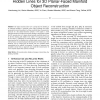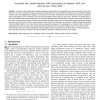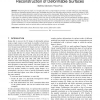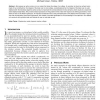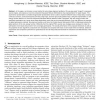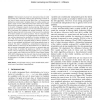128
Voted
PAMI
2011
14 years 3 months ago
2011
—3D object reconstruction from a single 2D line drawing is an important problem in computer vision. Many methods have been presented to solve this problem, but they usually fail ...
123
Voted
PAMI
2011
14 years 3 months ago
2011
— Projection methods have been used in the analysis of bi-tonal document images for different tasks like page segmentation and skew correction for over two decades. However, thes...
133
click to vote
PAMI
2011
14 years 7 months ago
2011
—A majority of the existing stereo matching algorithms assume that the corresponding color values are similar to each other. However, it is not so in practice as image color valu...
122
click to vote
PAMI
2011
14 years 7 months ago
2011
—Recovering the 3D shape of a nonrigid surface from a single viewpoint is known to be both ambiguous and challenging. Resolving the ambiguities typically requires prior knowledge...
167
Voted
PAMI
2011
14 years 7 months ago
2011
—We propose an active contour (a.k.a. snake) that takes the shape of an ellipse. Its evolution is driven by surface terms made of two contributions: the integral of the data over...
122
Voted
PAMI
2011
14 years 7 months ago
2011
—This paper introduces a novel contextual model for the recognition of people’s visual focus of attention (VFOA) in meetings from audio-visual perceptual cues. More specificall...
111
Voted
PAMI
2011
14 years 8 months ago
2011
—In this paper, we introduce a novel method to solve shape alignment problems. We use gray-scale “images” to represent source shapes, and propose a novel two-component Gaussi...
132
click to vote
PAMI
2011
14 years 8 months ago
2011
—In solving complex visual learning tasks, adopting multiple descriptors to more precisely characterize the data has been a feasible way for improving performance. The resulting ...
146
click to vote
PAMI
2011
14 years 8 months ago
2011
—Inferring latent structures from observations helps to model and possibly also understand underlying data generating processes. A rich class of latent structures are the latent ...
121
Voted
PAMI
2011
14 years 8 months ago
2011
—We propose a convex formulation for silhouette and stereo fusion in 3D reconstruction from multiple images. The key idea is to show that the reconstruction problem can be cast a...
